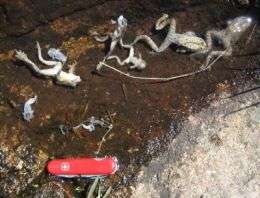New report details historic mass extinction of amphibians

Amphibians, reigning survivors of past mass extinctions, are sending a clear, unequivocal signal that something is wrong, as their extinction rates rise to unprecedented levels, according to a paper published by the Proceedings of the National Academy of Sciences (PNAS). Humans are exacerbating two key natural threats – climate change and a deadly disease that is jumping from one species to another.
The authors confront the question of whether Earth is experiencing its sixth mass extinction and suggest that amphibians, as a case study for terrestrial life, provide a clear answer. "A general message from amphibians is that we may have little time to stave off a potential mass extinction," write co-authors Vance T. Vredenburg, assistant professor of biology at San Francisco State University, and David B. Wake, curator of herpetology in the Museum of Vertebrate Zoology at University of California, Berkeley, in the August 12 issue of PNAS.
Amphibians are among the oldest organisms on earth, having survived the last four mass extinctions. The current extinction rate of amphibians is cause for alarm, according to biologists.
"An ancient organism, which has survived past extinctions, is telling us that something is wrong right now" Vredenburg said. "We -- humans -- may be doing fine right now, but they are doing poorly. The question, really, is whether we'll listen before it's too late."
While many factors have been cited for the profound change in global amphibian populations, a new emerging infectious disease, chytridiomycosis, is thought to be directly responsible for wiping out more than 200 species. It poses the greatest threat to biodiversity of any known disease. An aquatic fungus of unknown origin, it's the first of its kind to infect vertebrates, and only amphibians.
Understanding the ecology of chytridiomycosis may not only help amphibians, but human health. Scientists seek to map how the pathogen is transmitted from one species to another to develop ways to prevent or control outbreaks.
The Sierra Nevada Yellow-legged Frog is an example of a species under threat of extinction. In 2001, chytridiomycosis was detected in the mountains of the Sierra Nevada, and subsequently the authors have documented mass die-offs and the collapse of populations because of outbreaks. The fungus is surprisingly virulent, according to authors, and how it causes death is not yet known.
"It's important for people to understand what's infecting and killing these frogs," Vredenburg said. "This disease is a remarkable example of a pathogen jumping boundaries and causing havoc. If we can understand how it is able to do so, we may be able to help the frogs as well as ourselves."
On the Net: amphibiaweb.org
Source: San Francisco State University















